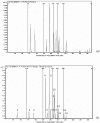Validation of an Analytical Method for Simultaneous Determination of 18 Persistent Organic Pollutants in Trout Using LLE Extraction and GC-MS/MS
- PMID: 32641934
- PMCID: PMC6934947
- DOI: 10.22037/ijpr.2019.1100748
Validation of an Analytical Method for Simultaneous Determination of 18 Persistent Organic Pollutants in Trout Using LLE Extraction and GC-MS/MS
Abstract
Persistent organic pollutants, (POPs), are vast distributed compounds in environment which are recognized as one of the global pollution problems. These groups of materials being dangerous due to their high stability are accumulated in animal tissues and occurring in the food chain. One of the major paths through which persistent organic combinations access to human body is consuming polluted foods, particularly, fishes. Among aquatic animals, trout as one of the mostly consumed fishes in Tehran's food basket was studied. In this study, two categories of persistent organic pollutants: Organochlorine pesticides (OCPs) including HCB, Dieldrin, Methoxychlor, α-, ϒ-Chlordane, α-, β-Endosulfan and o,p'-DDE, p,p'-DDE, o,p'-DDT, p,p'-DDT and the second group Polychlonitated biphenyls (PCBs) including seven PCB congeners which are called indicator PCBs (IUPAC nos.: 28,52,101,118,138,153 and 180) were determined in trout by GC-MS/MS in MRM monitoring mode and LLE extraction. The average recoveries of OCPs and PCBs at five concentration levels (1, 2, 5, 10 and 20 ng/g for PCBs and 5 times for OCPs) were in the range of 73-112%. The relative standard deviations of POPs in fish were in the range of 1.4-17.9% for all of the concentration levels. The limit of detections (LODs) and the limit of quantitations (LOQs) were between 0.6-8.3 and 2-25 µg/kg, respectively. The results indicated the presence of organochlorine pesticides in trout and the levels of p,p'-DDE and p,p'-DDT were within the range of < LOQ -12.83 and < LOQ -10.2 ng/g ww (wet weight), respectively. According to the results, OCPs residues were lower than maximum residue levels set by European Council Directives.
Keywords: GC-MS/MS; Iran; Liquid Liquid Extraction; Organochlorine pesticides; Persistent Organic Pollutant (POPs); Polychlonitated biphenyls; Trout.
Figures






References
-
- Mussalo-Rauhamaa H. Partitioning and levels of neutral organochlorine compounds in human serum, blood cells, and adipose and liver tissue. Sci. Total. Environ . 1991;103:159–75. - PubMed
-
- De Voogt P, Wells DE, Reutergardh L, Brinkman UATh. Biological activity, determination and occurrence of planar, mono and di-ortho PCBs. Int. J. Environ. An. Ch. . 1990;40:1–46.
-
- Eisenreich SJ, Loonez B, Thorton JD. Airborne organic contaminants in the Great Lakes ecosystem. Environ. Sci. Technol. 1981;15:30–8.
-
- Furst P, Furst C, Groebel W. Levels of PCDDs and PCDFs in food-stuffs from the Federal Republic of Germany. Chemosphere . 1990;20:787–92.
-
- Alcock RE, Behnisch PA, Jones KC, Hagenmaier H. Dioxin-like PCBS in the environment-human exposure and the significance of sources. Chemosphere . 1998;37:1457–72. - PubMed
LinkOut - more resources
Full Text Sources
Miscellaneous
